The Naked Neck chicken is a unique heritage breed with a distinctive appearance. With nicknames like Turken (Turkin chicken), Churkey, and also known as the Transylvania naked neck chicken, there’s a lot of fun stuff to learn about this bird.
The Naked Neck chicken is a relatively new breed in the United States, only recognized by the American Poultry Association in 1965.
Despite its recent history, this chicken has become quite popular among backyard chicken keepers and hobby farmers due to its unique appearance and friendly personality.
In this article, we’ll explore the history of the Turken chicken, its physical traits, how it differs from other chicken breeds, egg and meat production, care requirements, and whether or not it would make an excellent addition to your flock.
If you’re looking for an egg-laying chicken that looks like a turkey and is an unsung hero in the meat bird arena, consider this chicken for your flock.
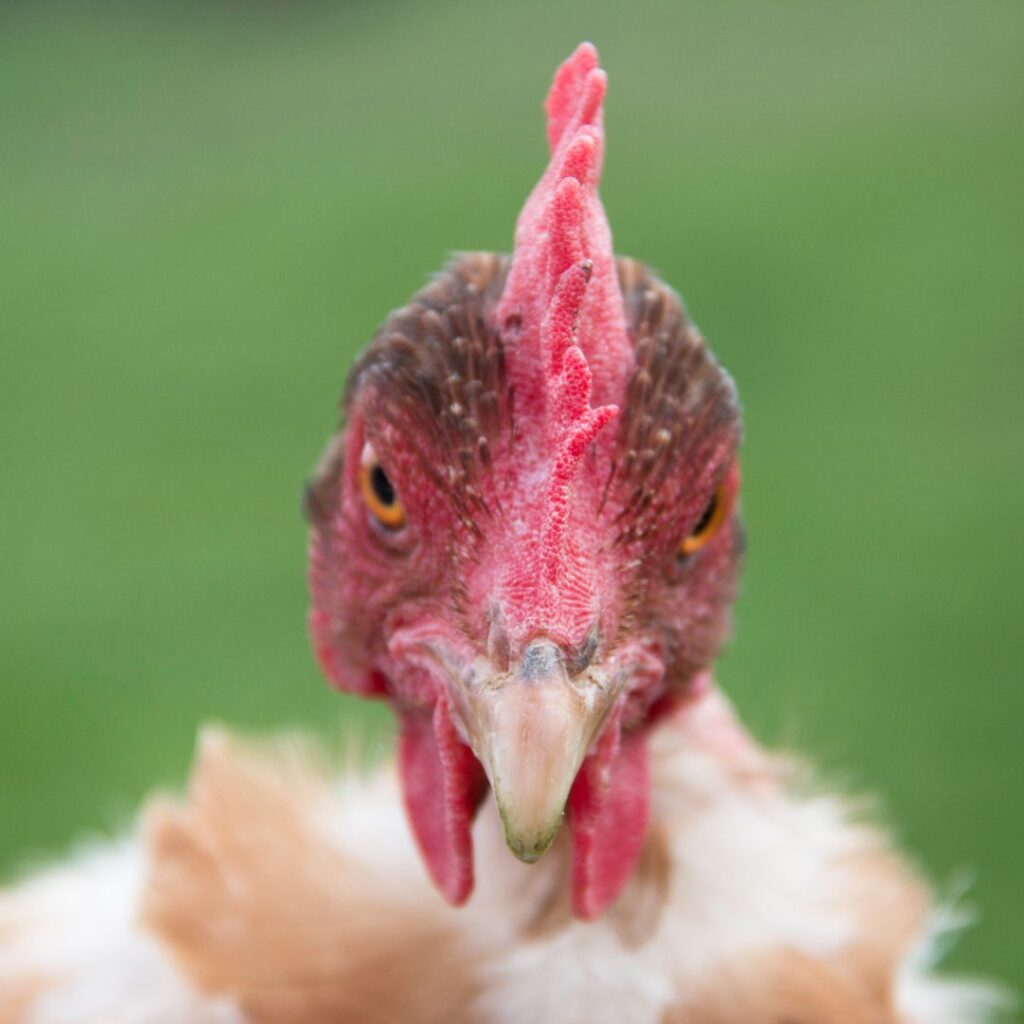
History of Naked Neck Chickens
The Naked Neck chicken is a breed that has long been prized for its unique appearance. While the breed’s exact origins are unclear, it is thought to have originated in Asia, where it has been bred for centuries for cockfighting.
Naked Necks were eventually introduced to Transylvania (today a part of Romania), where its breeding is documented back to 1918. The breed was then introduced to Germany, where it was refined. Later, the Naked Neck made its way to the remainder of Europe and the Americas.
The Naked Neck is often called Turken, Churkey, or Transylvania Naked Neck. Despite the name, these fowl are from Romania (Transylvania).
Naked Neck Chickens get their nicknames (Turken, Churkey) from their long naked necks and heads with turkey-like appearances. They are not related to turkeys in any way. However, they make excellent backyard chickens and good egg layers too! If you’re looking for a chicken that’s a little different than the rest, then the Naked Neck might be the right choice for you.
Why Do The Chickens Have Naked Necks?
A new DNA study has shown that the Transylvania naked neck comes from a random genetic mutation that causes the production of a feather-blocking molecule called BMP12. The was initially seen in domesticated chickens in northern Romania hundreds of years ago. The naked neck chicken, also called the churkey or turken, has a chicken-type body and a turkey-looking head with a long, red neck.
Surprisingly, when scientists injected BMP12 into standard-breed chicken embryos in a lab, the young chickens developed no neck feathers—suggesting the neck is more sensitive to the naked neck molecule. This is according to a study by Denis Headon, a developmental biologist at the University of Edinburgh’s Roslin Institute.
A study showed that naked-neck chickens have many advantages over their feathered counterparts. The naked-neck gene provides several benefits to the chicken, including improved breast size and reduced heat stress.
Additionally, in tropical climates, the naked-neck trait facilitates lower body temperature, increased body weight gain, better feed conversion ratios, and carcass traits compared to ordinarily feathered broilers.
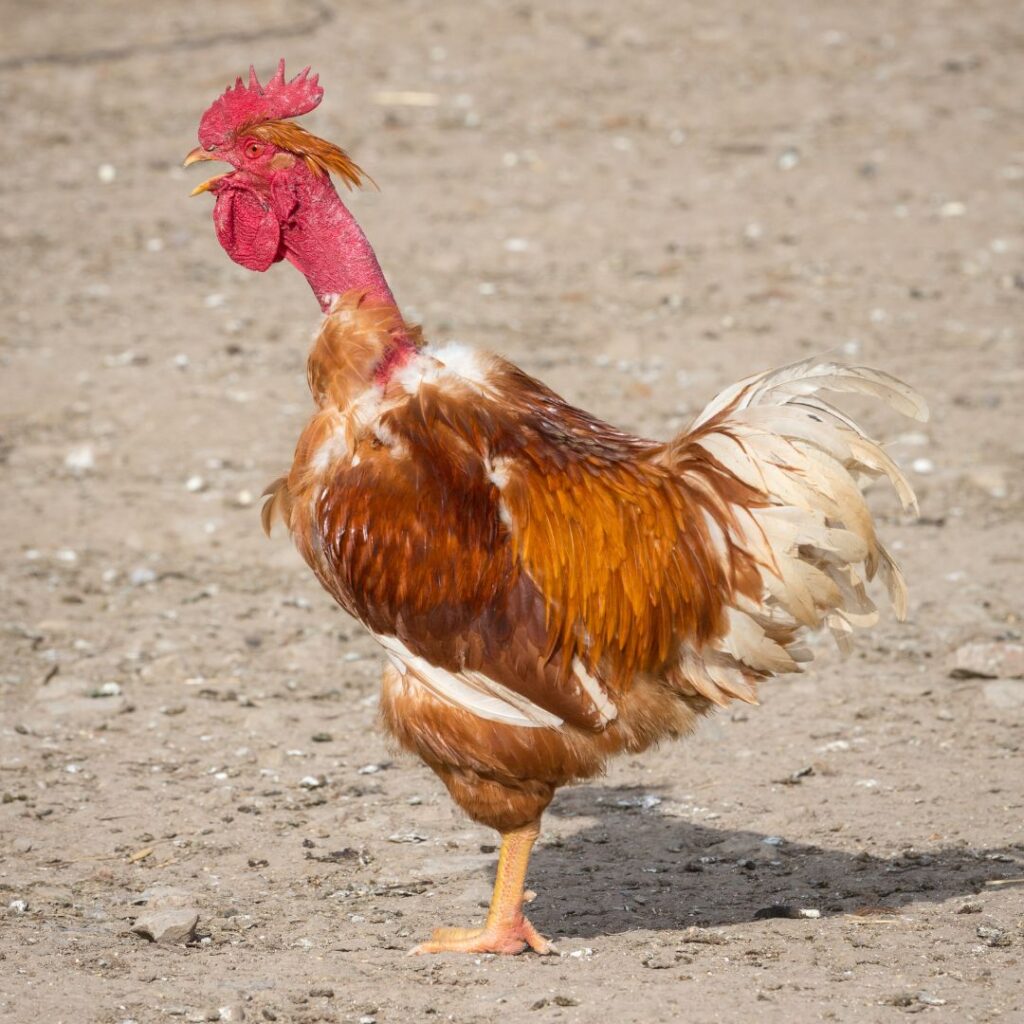
Breed Standard and Appearance
Naked Neck chickens are an extra-large poultry breed, with roosters weighing 8.5 pounds and hens at 6.5 pounds when fully grown.
They get their nickname from their resemblance to turkeys and share some traits with them – most notably, the lack of feathers on their necks and heads and their featherless bottoms. Naked Necks are also known for their featherless necks and having fewer feathers overall than traditional chicken breeds – anywhere from 40-50% fewer. This “naked” neck helps these birds stay cool in hot weather.
In addition to their unique physical appearance, Naked Necks are also easily identified by their reddish bay eyes, yellow legs, beak, and skin. The exposed skin on their necks is red, becoming a bright red in warm temperatures and seen as a pinkish-light-red color in cooler climates. Their comb is bright red single and medium-sized, with five points, and they have medium-sized red earlobes that are oblong.
more bare-neck chicken photos in the video below (pictures of turkens)
What Do Naked Neck Chicks Look Like?
At hatch, Naked Neck, chicks are born with featherless necks, traditional fluffy down on their heads and bodies. The down on their heads will fall out as they grow.
One advantage of Naked Neck chicks is that they’re effortless to identify as chicks. This can be helpful if you’re keeping multiple breeds and need to know which ones are which.

Color variations
The American Poultry Association recognizes naked Necks in Large Fowl, and American Bantam Association in bantams.
The APA recognizes these varieties:
- Buff
- Black
- Red
- White
Other varieties of the Naked Neck breed not recognized by the APA are the
- Blue
- Blue Laced
- Blue Laced Red
- Cuckoo
- Golden-Salmon
- Mottled
- Partridge
- Splash
The ABA recognizes these varieties
- Blue
- Buff
- Black
- Cuckoo
- Red
- White
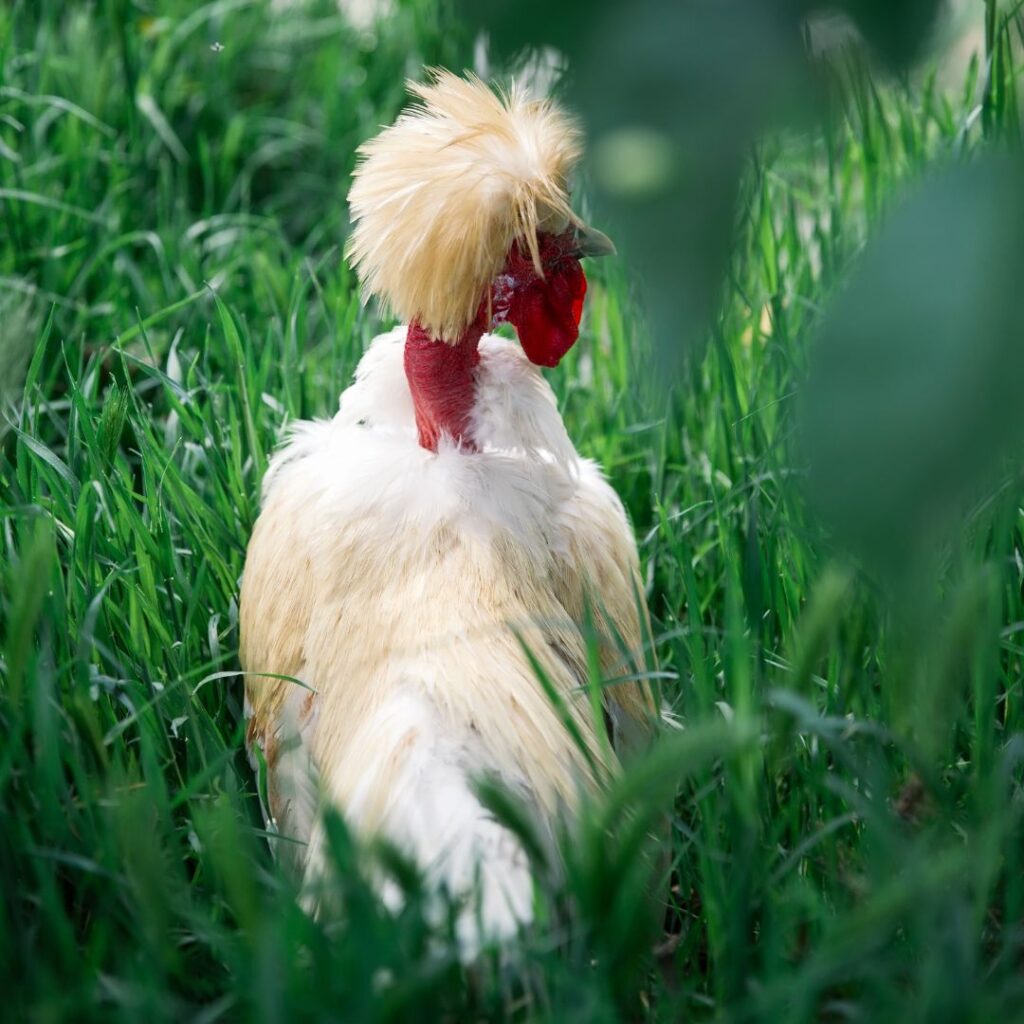
Other Naked Necks
The Transylvanian naked neck isn’t the only type of Featherless chicken–there’s also the French Naked Neck variety, which is often mistaken for its Romanian counterpart. There is also the Naked Neck gamefowl.
Personality
Despite their turkey-like appearance, these chickens are very friendly in terms of personality. The Naked Neck chicken is a friendly and loving bird you will adore. They are active and vigorous, and each one has its unique characteristics.
These birds are known to be goofballs, as well as extremely docile. They are sweet, cuddly, and loving and make great pets.
Is The Naked Neck Rooster Aggressive?
It’s normal for roosters to be aggressive when trying to win the attention of the hens. However, Naked Necks generally get along well with other chickens. While they don’t tend to be aggressive, they will stick up for themselves if necessary with another rooster.
Naked Neck Roosters can get along well with other standard-size breeds with similar docile personalities. Just remember to keep your Naked Neck roosters to a fair proportion with the hens. The recommended hen-to-rooster ratio is ten hens to one rooster.

Is The Naked Neck Chicken Noisy?
It is a common misconception that the Naked Neck chicken is a quiet breed. These birds are vocal and enjoy chatting with their owners and chicken roomies. While they can sometimes get noisy, their chatter is generally considered endearing. Of course, hens always make a louder announcement as they’re laying eggs.
The Naked Neck is undoubtedly a breed worth considering if you enjoy talking with your chickens. In addition to their Talkative nature, these birds are excellent with children and seniors.
Are Naked Neck Hens Good Layers?
Are Naked Necks good egg layers? Many people ask if turkens are good layers, and the answer is yes! They are great layers and excellent in all types of weather, from hot and humid to cold and breezy days.
The Naked Neck hens reach maturity around 20 weeks; you’ll start seeing eggs give or take a couple of weeks. On average, they lay about 200 a year, but some hatcheries state up to 240 eggs annually for many years. You can read more about how long chickens lay eggs in this link.

What Size and Color Eggs Do Naked Neck Hens Lay?
Naked neck chickens lay beautiful medium to large light brown.
Are The Turkens Good Meat Birds?
These Transylvanian Naked Neck chickens are good egg layers; many people also use them as meat birds. They’re a good size at 8 pounds making for a decent family meal.
Then there are the featherless qualities, making them much easier to pluck at the market. While not all feathers have been bred out of these chickens, the Naked Necks are much simpler to pluck than other types of poultry.
They are known to be meaty birds with skin that bubbles underneath, giving the meat a juicier, more flavorful taste than other broilers.
Do They Taste Like Turkey?
Not at all. These are all chicken outside and in, and Naked Necks have the American Poultry Association to back them on this!
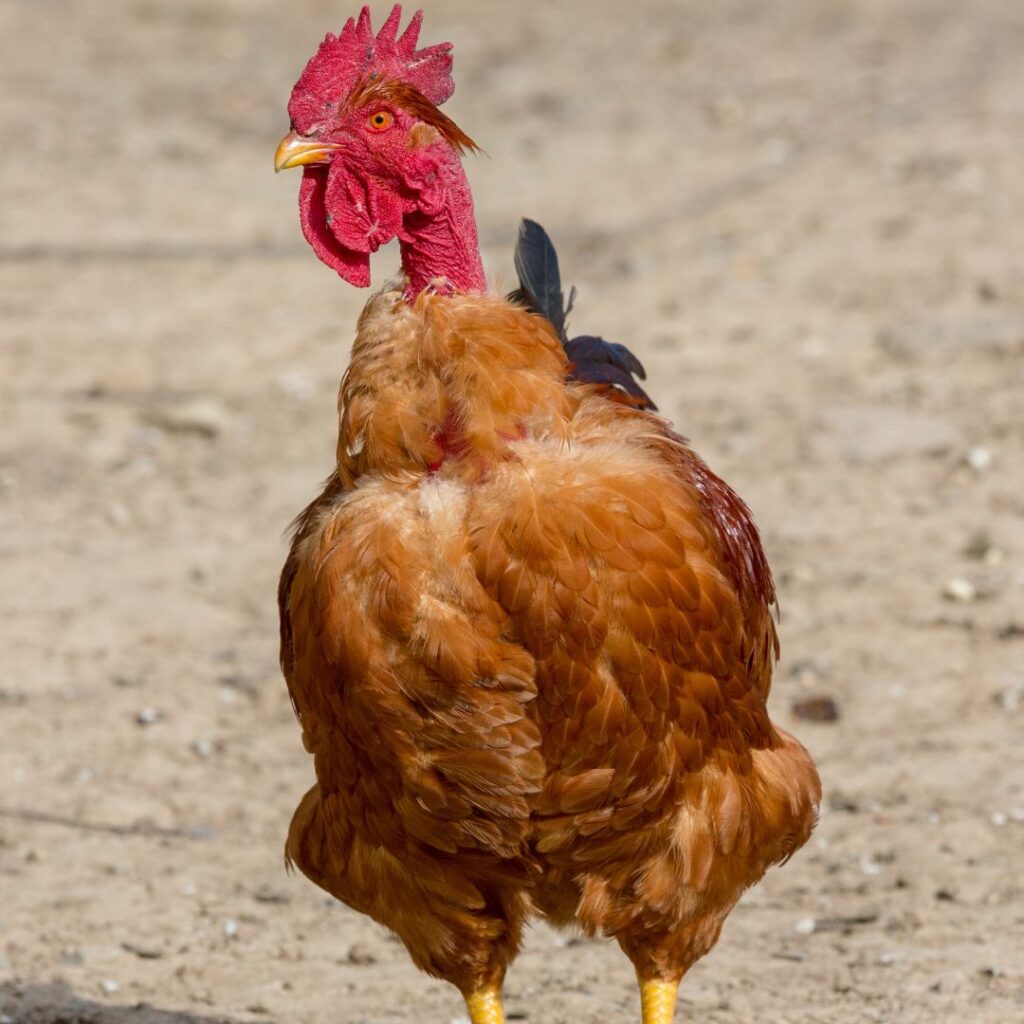
The Naked Neck Chicken Cold-Hardy or Hot Climates?
Naked-neck chickens are a unique breed that can tolerate cold and hot climates.
Despite their lack of feathers, they are very tolerant of cold weather. They will do just as well as the rest of your flock if given appropriate shelter and insulation for a cold winter.
In hot climates, the naked-neck chicken is also quite tolerant. They will do well if they have access to fresh water and shade.
Whether you live in a cold or hot climate, the naked neck chicken is an excellent choice for your flock.
Read more about heat-tolerant chicken breeds here.
Read more about cold-hardy chicken breeds here.
Care Of Your Naked Neck Flock
One of the great things about backyard chickens is that they are relatively low-maintenance. However, they still require care.
The Transylvania Naked Neck breed handles confinement very well with adequate space.
If you’re thinking about adding Naked Necks to your flock, there are a few things you need to know. First, it’s important to provide them with a warm, draft-free coop. Naked necks, featherless necks, and bottoms are especially susceptible to drafts, so be sure to pay close attention to this.
Additionally, you’ll want to be sure that the humidity levels in their coop are low. High humidity can lead to health problems for any chicken; humidity in winter increases cold temperatures, and humidity in hot weather can lead to respiratory problems.
Finally, remember to give them plenty of room to move around. Chickens need space to exercise and explore, so make sure to skimp on the size of their coop.
Chicken Coop
- Space Needs: Six square feet of space per bird should be available inside the coop.
- Coop Requirements: chicken coops need adequate ventilation and a door for easy cleaning.
- Before winter sets in and the temperature drops, take some time to prep your chicken coop. Good ventilation is key to reducing moisture, so make sure the air can flow freely. Be generous with bedding as it will insulate against the cold and keep your chickens warm. Inspect the coop for cracks or gaps that might let in chilly drafts – these are more common than you think! A little effort now will pay off when your chickens remain healthy and happy all winter long.
- We don’t often recommend heaters. However, it’s best to play it safe with this breed and have a heat lamp or another coop-specific heater.
- You can read all our tips on preparing a chicken coop for winter in this link.
- Prepare your chicken coop for the summer heat by ensuring it is well-ventilated. Check for any problem areas that require patching and cut down on flies. If you can, leave doors open to let in a breeze or put up screen windows/doors.
Nesting Boxes
Every four hens require one nesting box of the standard 12×12 size.
Roosts
Each chicken needs eight to twelve inches of roosting space. You’ll find them roosting closer together in the winter to keep warm. Roosts can be 2 – 4 feet above the ground.
Feeders and Waterers
Your chickens need a clean and reliable water source and enough food to maintain their energy throughout the day.
In winter, chicken waterers must be changed more often because the water will freeze in lower temperatures. If you want, you could buy a heated waterer or bowl warmer. However, this would demand your coop’s secure and safe power source.
If the weather is warm, your Naked Necks will need access to clean water more often; place additional waterers around the inside and outside of the coop. You can put ice cubes in the container to keep the water cool. In addition, keep waterers away in a shaded area or under cover if possible.
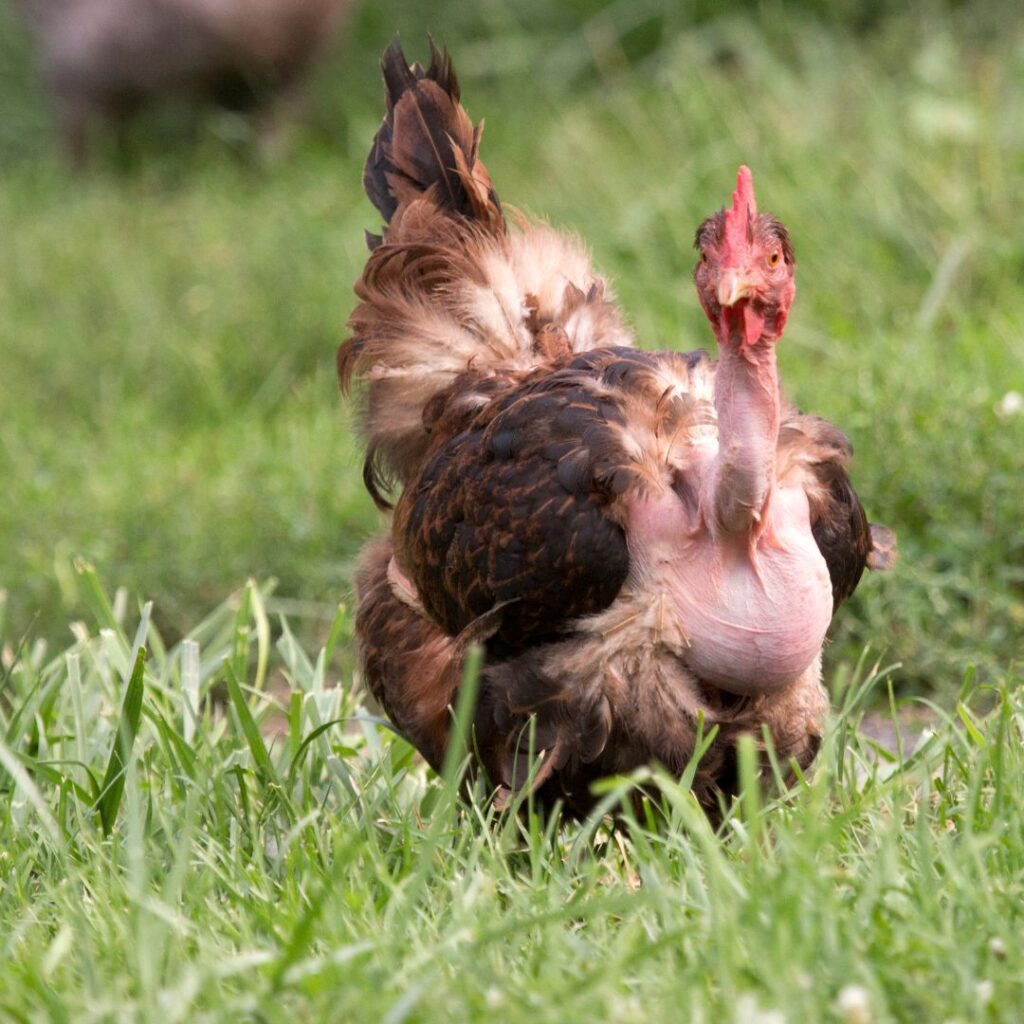
The Outdoor Chicken Run
Each Naked Necks chicken should have a minimum of fifteen square feet of outdoor space.
Perches
You can extend your ground space by adding lateral space with perches. A sturdy thick branch leaning up on the side of the coop or pieces of wood secured to the side of the chicken coop will work well. Even providing an old step ladder will do the trick.
Fence Height
Although they cannot fly, keep predators out of the run area with a secure 6-foot fence. To keep predators out and chickens contained, the run should be surrounded with chicken wire or other fencing.
The chicken runs should have no gaps in the fencing, making them escape-proof.
To prevent overhead predators, place hardware cloth over the outdoor run area.
Shelter
To protect against the outdoor elements, set up a Tarp or some shade cloth in the summer heat and a lean-to or tented area in the winter.
Dust Baths
By giving your chickens a designated place to take dust baths, you can significantly reduce and even eliminate the number of mites and lice that bother them during summer.
Weather Appropriate Treats
Not only do people enjoy treats during hot days, but chickens do too! If you have leftover vegetable peels or other kitchen scraps, you can freeze them in a bundt pan or another container. You can also use scratch or a combination of the two. Just fill the container with water and freeze it. Chickens will love to Peck at the frozen treat as it melts throughout the day. Not to mention, it helps with hydration and prevents boredom.
Keep your chickens entertained during winter with warm applesauce, oatmeal, baked apples, baked or mashed sweet potatoes, cooked carrots, or even cabbage.
Frostbite
Frostbite is a severe problem for chickens as it can cause immense pain and other health problems, sometimes even leading to death. To prevent this, be extra careful in preparing the coop ahead of time.
In addition, you can coat combs, wattles, and bare skin on necks and heads lightly with petroleum jelly, known to help reduce the risk of frostbite.
Are Naked Neck Chickens Good For Free Range Flocks?
The Naked Necks are a unique breed with several benefits for free-range flocks. Another benefit is that these birds love to forage. This means they will happily seek healthy grains, proteins, fruits, and vegetables while foraging in your yard. Their ability to forage can save you money on feed costs. An added benefit; this can help to keep your yard free of pests.
However, one downside of this breed is that it cannot take flight. They do not have enough feathers to support their weight. This makes the bird easy to prey on, especially free-ranging.
Are Naked Neck Chickens Good As Urban (City) Chickens?
As much as we’d love to see them in all U.S. flocks, urban locations with neighbors nearby should stay away from this breed. Their chatty nature and occasional ‘hen party’ getting loud can be a problem in a city or urban setting. As urban poultry keepers, you want your neighbors happy so you can keep your flock without issues. Find out more about quiet chicken breeds here.
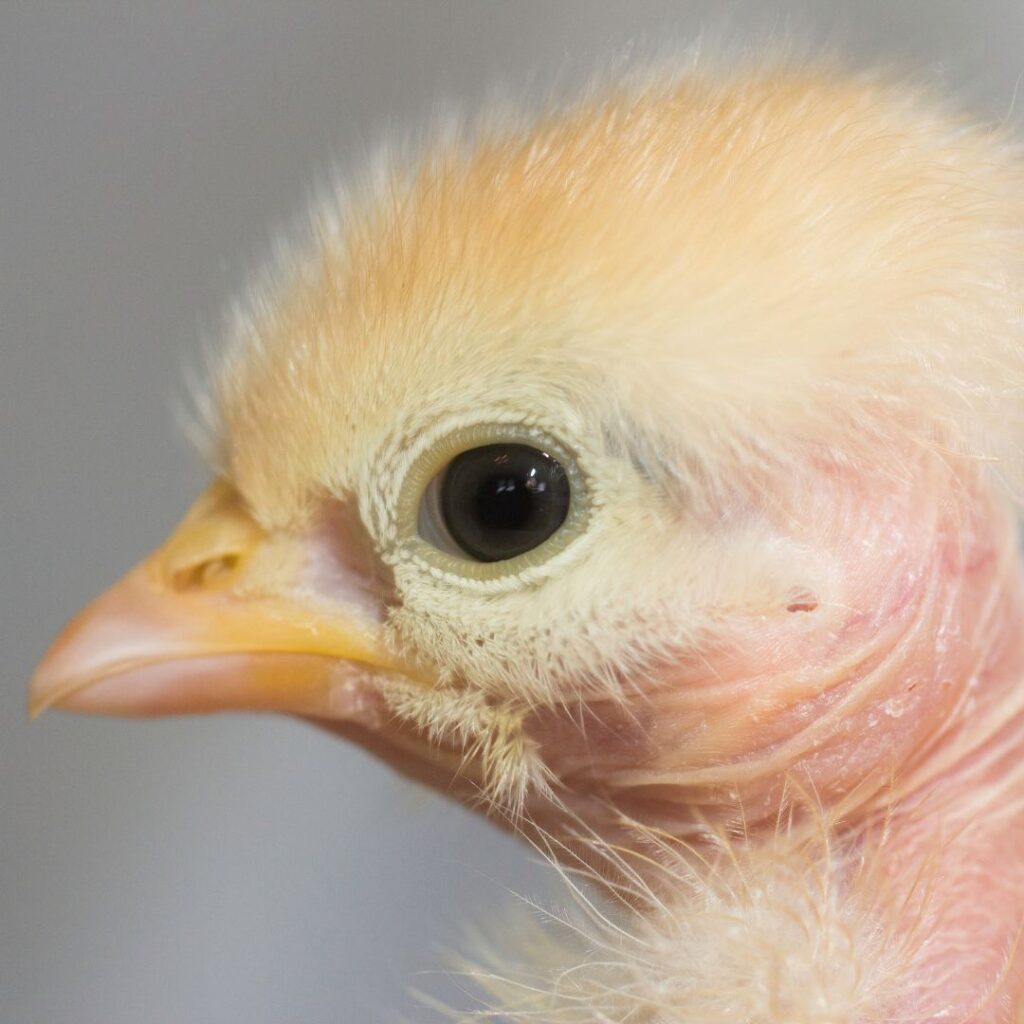
Is Transylvanian Naked Neck Chicken, A Good Choice for Backyard Chicken Keepers, Hobby Farmers, or Homesteaders?
The Turken chicken is a unique breed with a distinctive appearance. If you’re looking for an egg-laying chicken that is a champ as a bird, consider this chicken for your flock.
Their unique appearance is comparable only to their quirky, individual personalities, with some of the best qualities for a garden or yard buddy one could ask for. Can you imagine the punny names for chickens of this breed must be? Hobby farmers in the U.S. are just starting to learn about the benefits of having these feathered friends, so don’t be surprised to find one visiting you on your next visit to a farm stand.


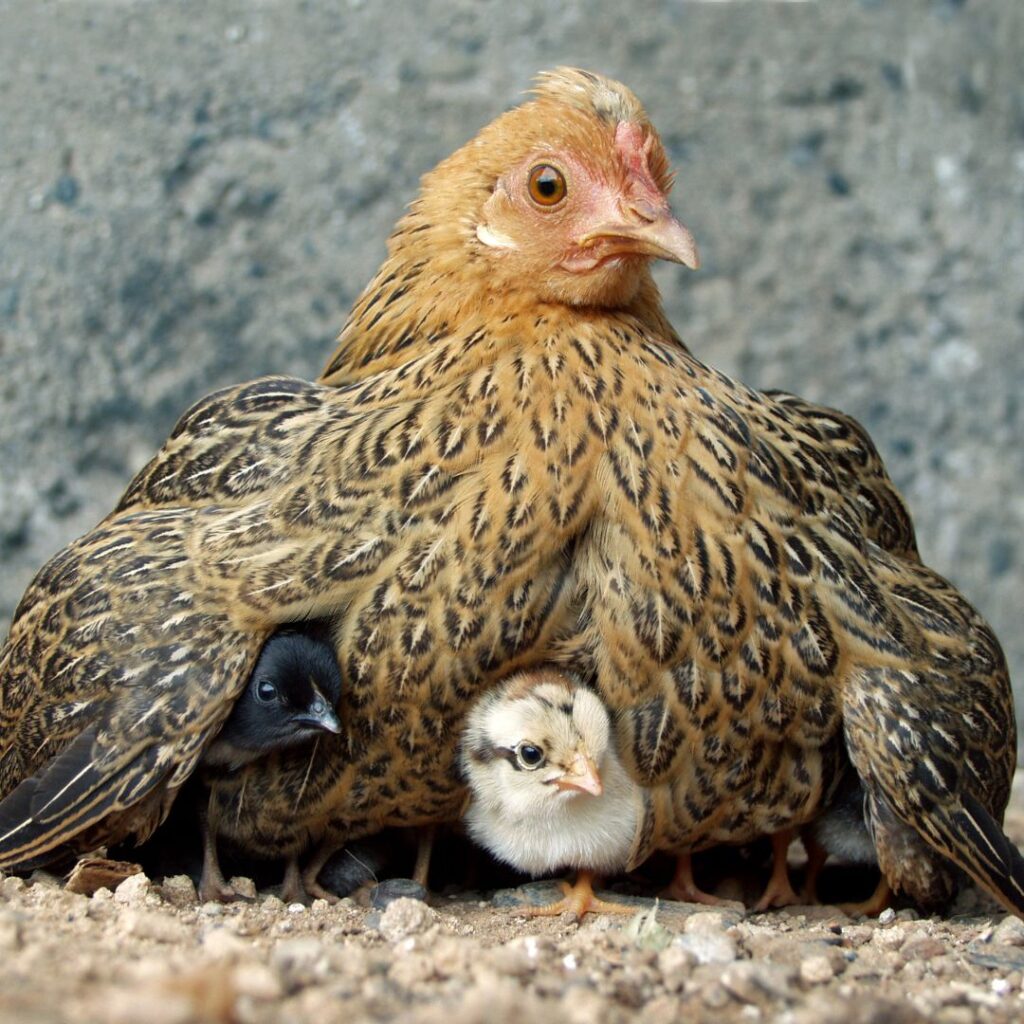
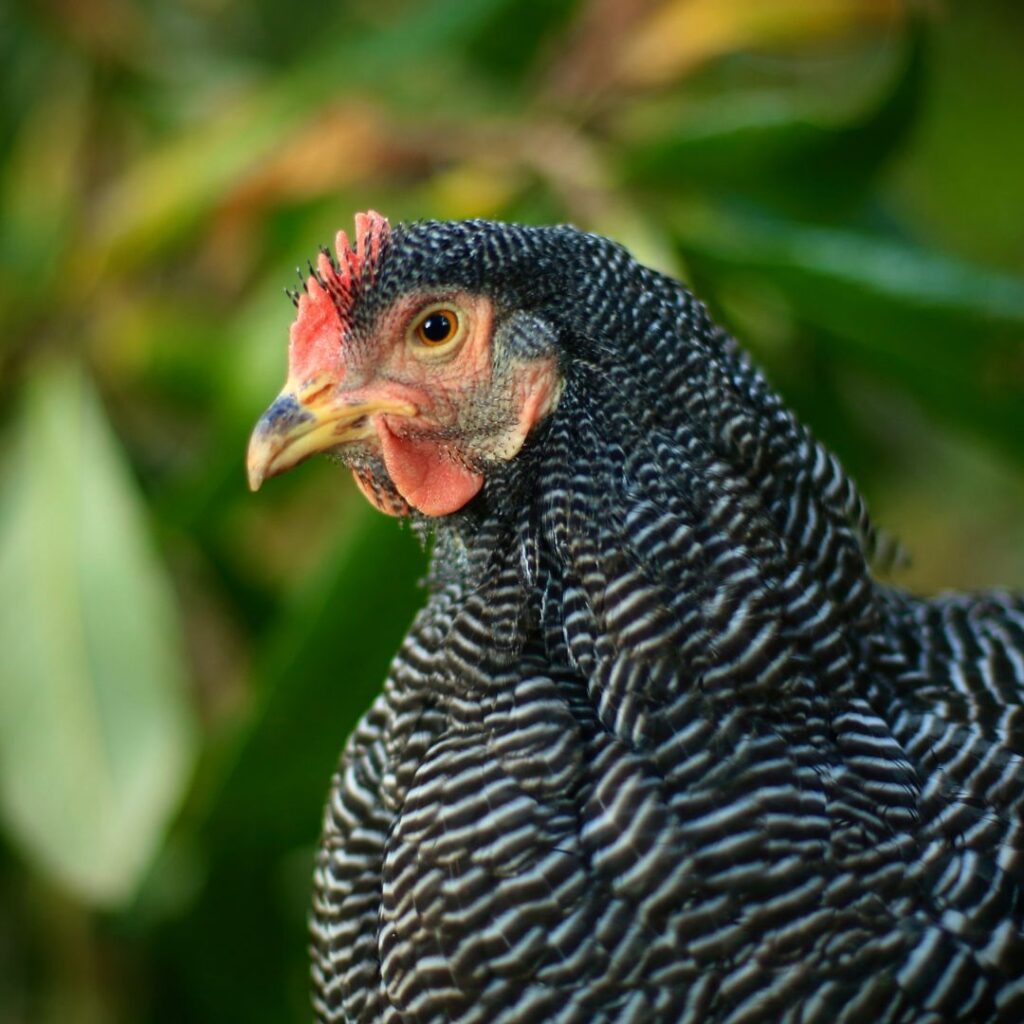
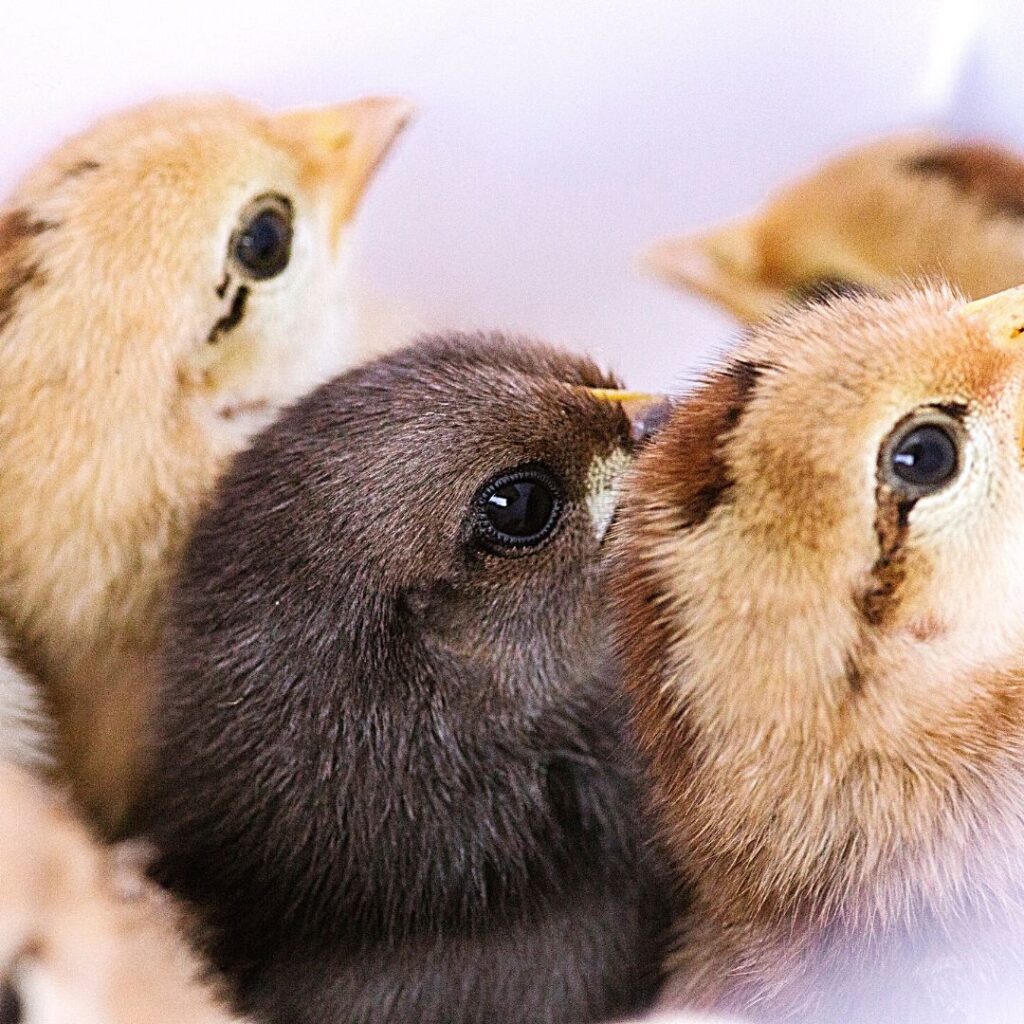
Pingback: New Hampshire Chicken; New Hampshire Reds
Pingback: 15+ Best Egg Laying Chicken Breeds; Qty, Color, Size Of Eggs
Pingback: Delaware Chicken Breed; Everything You Need To Know